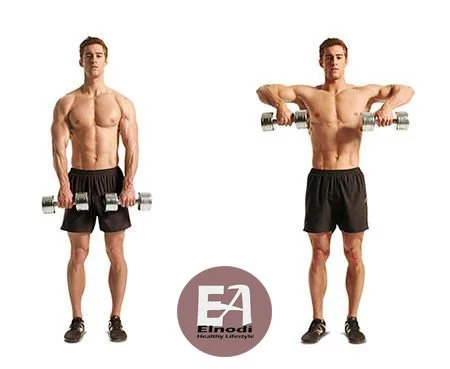The Dumbbell upright row is one of the most important exercises for overall shoulder development. Not only will it help shape your traps and shoulders, but it also will build strength in your middle and upper back muscles.
If you are looking to sculpt your shoulders and develop strong traps and shoulders, then you should add an upright row into your routine. Just make sure to use the correct techniques and be consistent with them. (1)
What Is A Dumbbell Upright Row?

A compound exercise that works your deltoids (shoulders), traps (upper back), and biceps is the dumbbell upright row.
It’s a really simple exercise to perform. You hold a dumbbell in each hand and lift them vertically until they’re level with your collarbone, before lowering them back down.
Despite being a straightforward move, it’s quite simple to go wrong. It’s crucial to perfect the technique to make sure you’re utilizing your traps’ potential for muscle growth to the fullest.
Dumbbell Upright Row Benefits
1. Muscle Strength & Growth
It targets a sizable number of the main upper body muscles with its targeted pulling motion.
Performing this exercise regularly is likely to accelerate your muscle growth and strength in your back, biceps, and shoulders. (2)
2. Stability And Conditioning
Research shows that the upright row is one of the best exercises for building shoulder strength and stability.
It is ideal for upper body stability and conditioning since it engages all of the key shoulder muscles. You can strengthen your stance while preventing injury by performing repeated upright rows.
Increase unilateral muscle development and correct any asymmetries and movement abnormalities by using dumbbells in the upright row. (3)
3. Builds Traps
Building traps is difficult. Only a few workouts concentrate primarily on your traps.
The traps are equally worked during an upright dumbbell row as the shoulders.
4. Arm Power
Upright row targets the muscles in your arms, including the biceps, forearms, and triceps.
This workout can increase your arm strength and make it easier for you to carry out daily duties.
5. Improve Your Posture
When performed correctly, it helps to strengthen the muscles that stabilize your upper body, enabling you to stand tall and maintain a straight back.
Muscles Targeted by the Dumbbell Upright Row

Trapezius
The kite-shaped sheet of sinew that extends vertically from the center of your back to your neck and out toward your shoulders is made up of your traps. The trapezius aids in neck extension as well as raising, lowering, and retracting your shoulders.
Deltoids
Your upper arms’ muscle caps are made up of three heads: the anterior (front), lateral (side), and posterior (back). In front of you, to the side, and behind you, respectively, they lift your arms.
Biceps
Your biceps, which are situated in the front of your upper arm, help rotate your palms upward in addition to bending your elbows.
How to do Dumbbell Upright Row

Instructions
- Select the appropriate weight from the rack, then take a shoulder-width stance with a narrower grip.
- Take a deep breath, then bring the dumbbells as close to your chest as possible while pulling them straight up the front of your body.
- Dumbbells should be gradually lowered back to their starting position.
- The required number of times should be repeated.
Dumbbell Upright Row Tips
- Keep your elbows up, but avoid letting your upper arm extend over parallel as this could lead to impingement.
- The shoulders may need to be raised and some subacromial space may need to be opened up if you have shoulder pain while performing the movement.
- Keep your back straight as you lift the dumbbells.
- Try to avoid excessive movement if at all feasible because any additional momentum used during the movement may potentially shift the strain to other compensating muscles.
- Make sure the head doesn’t lean forward while you drive the elbows high. (4)
Common mistakes and how to fix them
You will almost always witness some errors in and around the gym, as with the majority of free weight workouts. It’s critical to use proper technique and prevent any unneeded injuries. You’ll want to avoid the following blunders.
Swinging the weights
You see this a lot when the weight is in front of you. Swinging the weight up, using your momentum, takes away the tension from the muscles — meaning the exercise will be less effective.
This not only limits your ability to gain muscle, but it also increases your risk of injury, much like with most workouts when improper form is used.
Swinging the weight and using momentum can be a sign that you’re trying to lift too heavy. Don’t be afraid to use a lighter weight.
Never bend forward to gain an advantage; instead, keep your back straight. You’ll be deceiving no one except yourself.
Going too heavy with little range of motion
This is not a workout for lifting large objects. Using large weights runs the risk of hurting yourself and limiting your range of motion.
With dumbbell upright rows, form is more crucial than with sitting shoulder presses, where you can lift bigger weights. Avoid ego boosts. Choose a weight that is appropriate for you and enables you to perform all of your reps.
Safety And Precautions
- Throughout the workout, maintain a straight back.
- Avoid rounding your shoulders or arching your back.
- Avoid raising the dumbbells excessively.
- Use moderate amounts of weight.
Variations and alternate exercises
Lateral raises
Exercises that target the deltoids and aid to develop larger shoulders are lateral raises, or lat raises as they are more generally called. It’s a fairly straightforward practice, yet it works wonders. But just because something is simple doesn’t necessarily make it simple. Even with small weights, lat raises can be challenging, so pick your weight carefully.
Seated dumbbell shoulder press
If you want to develop huge, broad shoulders, this strong motion is ideal. The front deltoids (delts) are worked during the seated dumbbell shoulder press, which also increases your ability to lift heavier weights. This is because the bench will support your torso and other stabilizing muscles, allowing the shoulders to receive all the attention.
Dumbbell Arnold press
This workout is efficient since it works each of the three deltoid portions. The outcome? Without having to carry much weight, your shoulders will become fuller, wider, and more defined. This is so that the Arnold press can promote muscular growth by keeping the muscles under tension for a longer period of time.
Dumbbell front raise
One of the best workouts for strengthening your front delts is the dumbbell front rise. The front and sides of your shoulder will become stronger and more defined thanks to this isolated shoulder flexion exercise.
Dumbbell upright row workout
- Warm-up: Perform light cardio for 5–10 minutes, then dynamic stretches.
- Exercise: Do 3 sets of 10-12 repetitions of dumbbell upright rows.
- Cool-down: Static stretches should last 5–10 minutes.
Summary
Although the muscles in your shoulders are the smallest and in no way resemble those in your back, having well-developed shoulders will really enhance your physique. Dumbbell upright rows are the ideal supplement to your upper body workouts and a fantastic exercise for developing the shoulder and trap muscles.
Never lift too much weight; nobody wants a bad shoulder injury that makes it difficult to exercise the chest as well as the shoulders. Keep the weight at a level where you can finish 12 to 15 repetitions, with the final 2 to 3 being difficult.
Really, anyone can perform this exercise. To continue pushing yourself and your body, keep things fresh sometimes and avoid getting stuck on the same old routines.
FAQs
Is a dumbbell upright row better than a barbell?
What is the difference between shoulder press and upright rows?
Is Dumbbell Upright Row Good?
How Many Sets Of Dumbbell Upright Rows Should I Do?
References
1. McAllister, M. J., Schilling, B. K., Hammond, K. G., Weiss, L. W., & Farney, T. M. (2013). Effect of grip width on electromyographic activity during the upright row. The Journal of Strength & Conditioning Research, 27(1), 181-187.
2. Javorek, I. S. (1998). The benefits of combination lifts. Strength & Conditioning Journal, 20(3), 53-57.
3. Cools, A. M., Witvrouw, E. E., Declercq, G. A., Danneels, L. A., & Cambier, D. C. (2003). Scapular muscle recruitment patterns: trapezius muscle latency with and without impingement symptoms. The American journal of sports medicine, 31(4), 542-549.
4. Lorenzetti, S., Dayer, R., Plüss, M., & List, R. (2017). Pulling exercises for strength training and rehabilitation: movements and loading conditions. Journal of Functional Morphology and Kinesiology, 2(3), 33.





